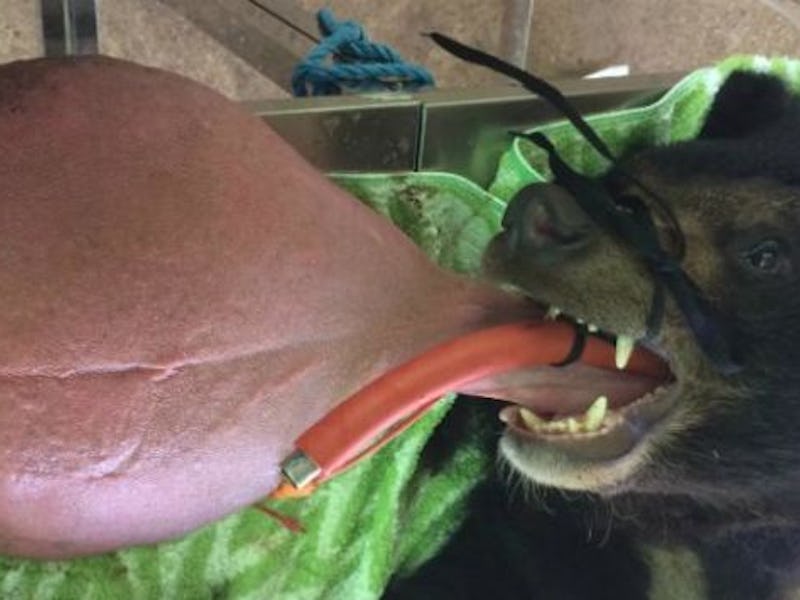Disease That Gave Bear a Monstrously Enlarged Tongue Affects Humans, Too
This sad bear has had a rough life.

Nyan htoo has had a rough life. First, the bear was captured, alongside his brother, by poachers in China. A bunch of monks in Myanmar rescued the pair from being sold to the illegal bile industry, but they soon realized that Nyan htoo (which means “bright”) was not well. His tongue began to swell to an alarming size, forcing surgeons to later remove parts of it. But the tongue grew back — and kept growing — to the point that the bear had to drag his tongue around on the floor.
By June of this year, Nyan htoo’s grossly enlarged tongue had begun to impede on his quality of life, forcing the Asian brown bear, or “moon” bear, to lean his head against the bars of his cage just to support the extra weight. Fortunately, the Animals Asia Bear Rescue Centre in Vietnam stepped in, and experts, including veterinary surgeon Heather Bacon of the University of Edinburgh’s Royal (Dick) School of Veterinary Studies, flew in to remove 6.6 pounds of tongue tissue from Nyan htoo. He’s now reportedly back to wrestling happily with his brother, Kan htoo (which means “lucky”).
All may be well for Nyan htoo now, but the mystery behind his illness remains. The team that treated him think that he had a form of lymphatic filariasis, a disease better known as “elephantiasis” because of its enlarging effect on limbs.
Asian brown bears are poached for the illegal bile trade.
The weird part is that elephantiasis is normally characterized as a human disease, one that’s caused by infection with certain types of nematode worms (Wuchereria bancrofti, Brugia malayi, and Brugia timori) carried by mosquitoes (Aedes, Culex, Anopheles, and Mansonia species) that are found in Africa, Central and South America, South Asia, and the Pacific Islands. When one of these mosquitos bites a human, they transmit the worm larvae into to person’s blood, which serves as their home for the next four to six years.
As they get comfortable in the body, the worms multiply and start clogging up the body’s passageways — in particular the lymphatic system, which is usually responsible for the flow of lymph to and from our limbs. Blocking the passage of lymph with a ball of worms can cause it to get stuck in the extremities, which is what leads to the buildup of fluid in certain parts of the body, especially the legs and genitalia.
Nyan htoo’s case, however, suggests that the lymph capillaries feeding organs higher up in the body can be blocked by the worms as well.
Elephantiasis usually causes swelling in the lower extremities due to buildup of lymph fluid.
In humans, the swelling can be extremely painful, and it’s often accompanied with severe swelling elsewhere and fevers caused by bacteria collecting in the stopped-up fluid. Nyan htoo was likely bound for the same fate, if elephantiasis was indeed what he was suffering from. It’s hard to say: When it affects animals (usually cats and monkeys), it’s thought to have a distinctly different life cycle than it does in humans.
According to the World Health Organization, elephantiasis affects about 120 million people worldwide, causing significant disability and interfering with individuals’ ability to take part in society — thus “contributing to stigma and the cycle of poverty” that tends to be widespread in the areas where it is endemic. Treatment — which usually happens on a mass scale — usually involves taking drugs to kill the worms in the body, although most efforts to deal with the disease have focused on preventing the growth of the mosquitos that carry it.
Nyan htoo is the first bear that scientists have ever seen with the illness, said Caroline Nelson, a veterinary nurse at the Animals Asia Bear Rescue Centre in Vietnam, in an interview with the Scotsman.
Post-surgery, Nyan htoo's tongue is back to normal.
If you liked this article, check out this video of a scientist wearing a polar bear suit to study animals in the Arctic.